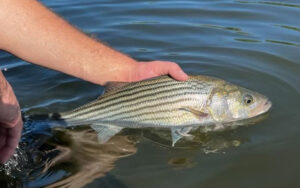
By Alex McCrickard/DWR
- Avoid fighting striped bass to exhaustion. Make sure you have a heavy enough rod and associated tackle to land the fish relatively quickly, especially if you are targeting trophy-sized striped bass.
- A large rubber net can be beneficial when landing striped bass. This will allow you to keep the fish wet while you prepare to remove the lure, fly, or hook. This also allows you to keep the fish wet if you’re preparing to take photos.
- Always wet your hands before handling striped bass and never handle them with dry hands. Handling any fish with dry hands can take the protective slime coating off, making them more susceptible to bacteria, parasites, and other pathogens.
- When photographing the fish out of the water, keep it quick to minimize air exposure and get the fish back into the water as soon as you can. Always support the weight of the fish with two hands and avoid a vertical hold on striped bass. Gripping the fish by the lower jaw while supporting the weight of the fish by holding it under the belly is best.
- You don’t have to take photos of every single striped bass you catch. Consider taking photos of particularly memorable fish on each trip and release the majority of the fish you land quickly.
- Avoid having striped bass contact boat surfaces such as carpet and metal when handling. When bank fishing on rivers or beaches, avoid having striped bass contact rocks and sand along the bank. If the fish must be on the ground for a brief period of time, make sure it’s on a wet surface such as wet sand instead of dry sand.
- Make sure you have a pair of long pliers, such as needle nose, for unhooking fish, especially for those fish that are hooked in hard-to-reach places.
- If the hook is too deep, it is best to cut the line as close to the hook eye as you can. Most non-stainless hooks will rust out and dissolve over time, which will give the fish a much better chance of survival than the stress that comes with attempting to remove the hook with pliers.
- When handling striped bass out of the water, make sure to keep your hands and fingers away from the gills and gill arches. Don’t hold the fish too tightly and never hold a fish by the eyeball sockets.
- When releasing striped bass, it’s important to let the fish recover on its own terms; the fish will swim out of your hands when it’s ready. Avoid tossing the fish back into the water as lactic acid builds up in the muscles during the fight, especially for larger fish. To help revive the fish, it is best to hold the fish upright and move the fish gently forward so water runs over the gills. When fishing in tidal water, rivers, and moving water, always face a fish upstream or against the current during a release.
- Consider using barbless hooks and single-point hooks instead of treble hooks.
- Use non-offset (inline) corrodible circle hooks when fishing for striped bass with bait. This is required by regulation when fishing for striped bass with live or chunk bait in brackish waters in Virginia. DWR strongly encourages the use of circle hooks for striped bass in Virginia’s inland reservoirs. Studies show that circle hooks prevent gut hooking and improve your chances of a successful release.

